Blog Archives
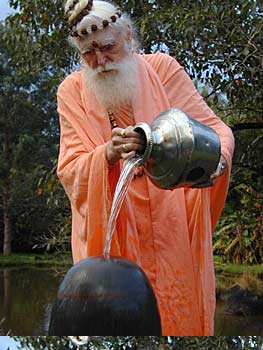
We are back from a wonderful three day retreat full of great activity… the color edition of Dancing with Siva is in the works and this picture of Gurudeva offering water to the Shiva Lingam on the Path of the Saiva Saints elicits this except from that wonderful book:
Sloka 111 from Dancing with Siva
Is Temple Worship Only for Beginners?
Temple worship is for all men and women at every level of spiritual development. Its meaning and experience deepen as we unfold spiritually through the stages of service, devotion, yoga and enlightened wisdom. Aum.
Bhashya
We never outgrow temple worship. It simply becomes more profound and meaningful as we progress through four spiritual levels. In the charya pada, the stage of selfless service, we attend the temple because we have to, because it is expected of us. In the kriya pada, the stage of worshipful sadhanas, we attend because we want to; our love of God is the motivation. In the yoga pada, we worship God internally, in the sanctum of the heart; yet even the yogi immersed in the superconscious depths of mind has not outgrown the temple. It is there–God’s home on the earth plane–when the yogi returns to normal consciousness. So perfect is the temple worship of those who have traversed the jnana pada that they themselves become worship’s object–living, moving temples. Yea, temple worship is never outgrown. The Vedas give praise, “Homage to Him who presides over all things, that which was and that which shall be; to whom alone belongs the heaven, to that all-powerful Brahman be homage! From Fullness He pours forth the full; the full spreads, merging with the full. We eagerly would know from whence He thus replenishes Himself.” Aum Namah Sivaya.
Our Beloved and Revered Satguru Sivaya Subramuniyaswami
Attained Maha Samadhi on November 12th, 2001
Click to read for Details.
Mystic Mouse Coloring Book Now available
Today’s sample page. —– Click here to get your copy today!
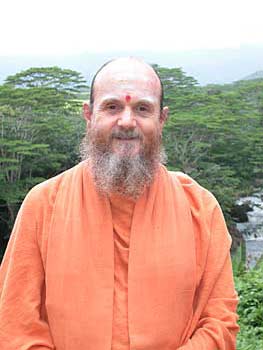
Bodhinatha sends his love and blessings out to all and thanks everyone who helped take care of him and the mathavasis traveling with him on his recent mission to Mauritius, Malaysia and Singapore.
No Audio Today
|
Take this opportunity for an adventure. Close your eyes and click to get a message picked at random from the vast audio archives of our Satgurus’ discourses |
And click here for an Index to All Past CyberTalks. Study Gurudeva’s teachings. Visit the Master Course site! |
|
September 23, 2002 |
 |
|
|
|
|
 |
||||
Our wonderful Sadhaka Tyaganatha is back with us after his trip with Bodhinatha, performing a dynamic Sun One homa.
The inner atmosphere was alive and the kundalini wide awake during the powerful rites.
Agniye, svaha!
On pilgrimage for a five days from the Hindu Worship Society of Houston, Texas are long time friends, Pandit Rajendra Sharma and his wife Asha, and their friend, Asha Chakku. Panditji is the priest of the temple and Asha Chakku is one of the temple’s trustees. Panditji and his wife are have come to Kauai Aadheenam from time to time through the years and are wonderful examples of a Hindu ministry family. More than a priest, Pandit also teaches and he and his wife also counsel their congregation. Gurudeva always encouraged them in their work and they have taken a lot of inspiration from Hinduism Today and Gurudeva’s writing. Panditji talks to the Hinduism Today staff about the issue of parents wrongly blaming their Hindu children for going in the wrong direction, when in fact it is the fault of the parents for not giving them proper exposure to Hinduism when they were young. Arumugaswami explains to them about our wonderful news service called Hindu Press International and engages Punditji to send writings in for Hinduism Today from time to time. The observe Chitra puja for Gurudeva each month in their temple and plan to hold a Mahasamadhi observance ceremony in November to coincide with ours here on Kauai.
Shirley Smail (on the right) is a metaphysical teacher in Southern California who brought a group of students from her Center of Light, based in San Diego area. Shirley has been on Innersearch, is a student of Himalayan Academy and uses, with Gurudeva’s blessings and encouragement, the contents of Merging with Siva in her classes and teaching work. A visit to the publications and a brief chat with our team which takes a moment’s break from their work on Dancing with Siva.
Here is a retrospective series from our monthly three-day full moon retreat on which the first day is called “Iraivan Day” when all the monks leave their normal duties in separate departments and converge to all help the Lombodara Kulam wtih all kinds of various projects for Iraivan Temple. Dressed in “greens” which are the work clothes worn by all the monks, a dynamic energy fills the monastery as everyone is delighted to be on the same team pushing Gurudeva’s visiion forward.
Arumugaswami working on the never ending task of the monthly mailing to all the donors.
It is always a joyful moment when envelopes are sealed and ready for the post office. Hands on mailing work is something that Gurudeva had his monks doing for decades, encouraging us all to “put your prana into each piece.”
Sadhaka Haranandinatha is manning the Iraivan desk while Sadhaka Thondunatha is in Sri Lanka for a few months visiting his parents. Writing personal notes in response to peoples queries, sending vibhuti on the occasion of someone’s birthday, reminding someone of their pledge, appreciations for donations, etc. is all part of this divine duty.
Meanwhile the talents and skills of the publications team are this day turned toward Iraivan Temple. Yogi Japendranatha works on a color flyer to be send to sponsors of different stones of the temple.
Sivakatirswami working on the Iraivan Temple web site.
After several months of consistently rainy weather, this past week has suddenly become bright and sunny. It is always a breathtaking vision to look at Mount Waialeale in the morning as the sun rises behind us in the east, cutting down the darkness in the valley…. the now waning moon, still clearly visible in the western skies for the next few days. We count our blessings every day.
Gurudeva’s spiritual center in the island country of Mauritius
in the Indian Ocean near South Africa
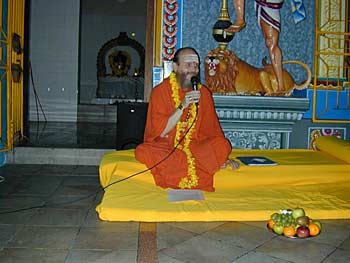
We bring you more wonderful pictures from Mauritius with details on Bodhinatha Mission there.
The members of the Vada Palani Temple at Grand Bay on the northern coast of the island of Mauritius invited His Holiness Satguru Bodhinatha to give a talk at their beautiful temple. After a nice puja by the Temple priest, Bodhinatha talked about Lord Siva , emphasizing on the importance of Temple worship and the need for the devotee to have his mind fully concentrated on the puja.

Bodhinatha’s talk was followed by a a few Bharat Natyam dances by Venilla Mardemooto. Our digital camera could not get a better shot of our talented young dancer due to interference from neon lights inside the temple. Venilla went to India and studied at the famed Kalashetra School of Fine Arts in Chennai. We are blessed to have her bring back to Mauritius her skills to share with us all and to teach the next generation.
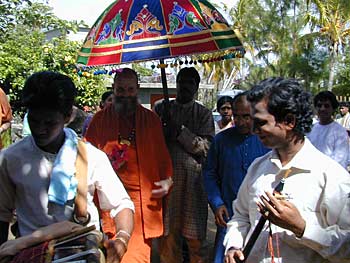
It was a real moment of joy when Satguru Bodhinatha Veylanswami arrived at the Spiritual Park on Ganesha Chaturthi. Children have been lined up to offer flowers at Bodhinatha’s Feet and traditional musicians led the way. The Park was already packed with thousands of devotees and when Bodhinatha crossed the Ganesha Bridge to enter the Mandapam, devotees stood up and were patiently waiting for the Satguru to be nearer to them to enjoy His darshan.
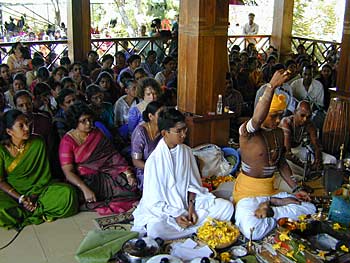
A special Homa was performed by Kadavul Hindu Temple priest at the Ganesha Mandapam. Hundreds of notes were burnt in the Homa to reach the Beings of the inner worlds. Everyone later said they never believed such a beautiful Homa could be performed on that day, and especially uplifted when our monks from Kauai chanted high powered sanskrit mantras.
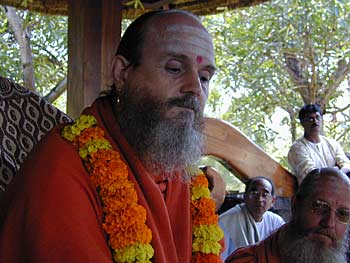
Bodhinatha is now a well known Spiritual Master in Mauritius. Many are those who rushed forward to His Feet for Blessings on that day.
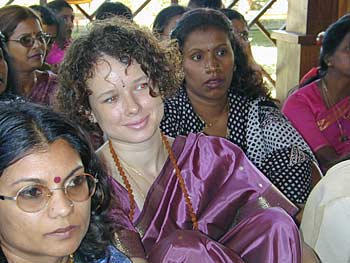
Our ladies attentively listening to Bodhinatha’s talking about satsanga. Here is Kavita Mardemootoo �who happily received Vishesha Diksha the day before.
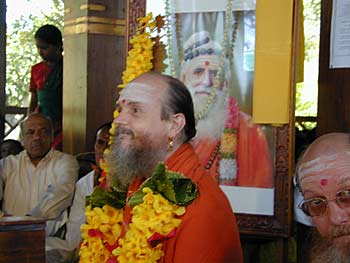
Gurudeva Sivaya Subramuniyaswami, Founder of Saiva Siddhanta Church in the photo and His Successor, Bodhinatha Veylan swami actively fulfilling Gurudeva’s vision in the island of Mauritius.
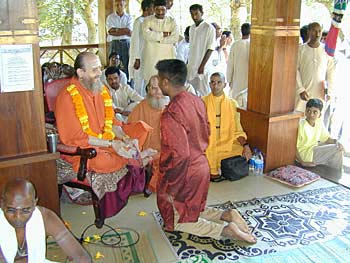
Here is Navind Sagam a new 2002 member of the Church receiving Bodhinatha’s Blessings. Navind is in his final year University degree studies in Computer engineering.

After the puja and talk in the Ganesha Mandapam everyone followed Bodhinatha into the tent where a cultural program was prepared for the Satguru. Here Venilla is performing a dance to Lord Ganesha.
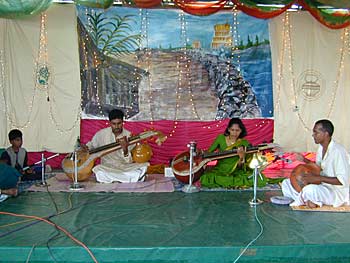
Another item at the program was a Vina recital by Kulamata Premila Manick, accompanied by her music instructor, Thiru Rajesh Marday, gold Medalist in Vina from South India. Premila has been studying Vina for over four years now.
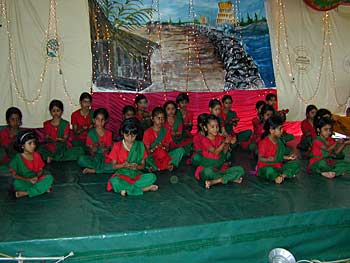
Here are the very young Bharat Natyam students of Venilla during a theoretical demonstration of that ancient art.
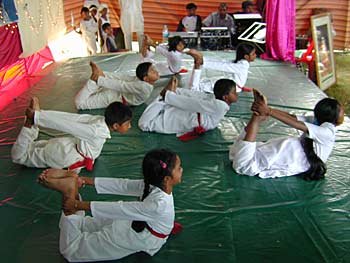
Our young Master Course students at the Dharmasala giving a Hatha Yoga demonstration. Many parents were impressed by the performance of the children.
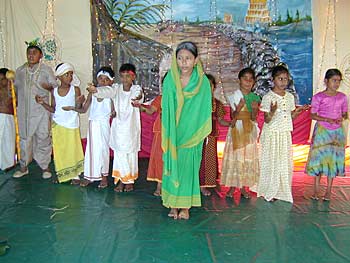
Another item presented by the very young ones was a skit on Book one. Here the little ones are playing different roles in the story of Semmana Selvi. We can see Vanaja dressed as the old Semmana, a worthy devotee of Lord Siva…… More photos on the Ganesha Chaturthi celebrations and the cultural show in our next Mauritius Mission series…..
| FULL INDEX OF 650+ CYBERTALKS
 |
|
Study Gurudeva’s teachings.
|
transcription begins
Date: August_18_2002
Title: 2002 Kauai Innersearch Day 2 Part 3
Category: Karma
Duration: 14 min., 30 seconds
Date Given: July 19, 2002
Given by: Bodhinatha
Turning to the third area, ‘Ten Principles for Effective Karma Management’, we will review the first two principles, then go on to principles three and four.
The first principle is ‘Forego retaliation’. The opposite of that, I have a quote for that, to start and then a quote for the right approach. “Revenge lasts for only a day, but oh, what a day!” That is the wrong approach, “Revenge lasts for only a day, but oh, what a day!” That is not in the Tirukural. The Tirukural says the right thing. It says, “The joy of the vengeful lasts for only a day but the glory of the forbearing lasts until the end of time.” So that is the correct approach. It also says, “Worthless are those who injure others vengefully, but those that stoically endure are like stored gold.” It is encouraging everyone to forego retaliation.
It is an interesting principle. It can be broadened out into a variety of situations. One of Gurudeva’s teachings is that at this time on the planet, any worthwhile endeavor has opposition. It is just the nature. You are trying to do something good, somebody will oppose it. You try and do something great, somebody will oppose it even more. So to expect that kind of opposition was Gurudeva’s wisdom. Not to not expect it. Some people don’t expect it and therefore they are disappointed. They are discouraged when they reach that kind of obstacle. They say, “Oh, so many people are against me. This is terrible.”
Well, Gurudeva would say, “So many people are against me, I must be doing something really good.” He would turn it around. He would expect the obstacle and when he encountered it, would measure the worth of what he was doing.
This principle applies into how to handle opposition. For example, when we first started publishing our magazine, ‘Hinduism Today’, on a broad scale, it was receiving recognition as a vehicle for uniting Hindus worldwide. We got some opposition from the VHP, Vishwa Hindu Parishad. They were concerned because they wanted to be the only umbrella, global, Hindu organization. That is their goal, Vishwa Hindu Parishad. They thought we had similar ambitions. So, they would criticize ‘Hinduism Today’. Of course, we were all CIA, which was quite a compliment! Funded by the government, we had this vast budget, which is also a compliment! You know, it must be a good publication for them to think the whole government is funding it!
It was a very interesting time and of course, we are on good relations now. It didn’t last because they realized that, that wasn’t our goal. We don’t want to be a global Hindu organization. We just want to be a magazine, that is all we want to be. We are not trying to be global, Hindu organization. So they didn’t feel we were competing after a while. But initially they did and so Gurudeva’s approach, which relates to this idea of forgoing retaliation, is what he called, “the friendly, firm wall.”
In a situation where a group is opposing you, you have certain rules. You don’t initiate contact with them. If they initiate contact with you, “friendly, firm wall.” Means, you smile and you say, “Oh, yes thank you.” Then, you promptly forget about whatever they have said. You do that enough times, what does it do? It creates a wall, it creates a distance between you and their group. Whereas if you interact with them either on your own initiative or responding to what they say, you start to tangle the two groups up. But if you keep the wall up, “friendly, firm wall”, what happens? Well, their antagonistic action hits the wall. What happens? It bounces back on them and it doesn’t hit you because you have tied yourself together. Eventually, the karma of what they are doing comes back on them and then it finally works itself out.
So, it shows how this principle can be used in business or in life or a number of situations, governments. It is not a principle which relates to just one person, it can be applied to a number of situations quite effectively.
Our second review is, ‘Accept Responsibility’. That is the second principle. We will start with a Kural quote. Yesterday, we were doing Gurudeva quotes, today it is the Kural. “Why should those who rejoice when destiny brings them good, moan when that same destiny decrees misfortune?” Definitely happens, right? Everybody is happy when their karma brings them something good. Everybody is sad when it brings them something difficult. A spiritual person might look at it the opposite way because he knows he unfolds more when he is facing difficulty. But that is not normal human nature. So, it is just human nature that is the answer. When we face difficulties we tend to get discouraged, we get externalized, we react emotionally, we don’t act wisely. It is human nature to go through that because we have hit something we have not expected.
Whereas what we need to do is to remain centered and act from wisdom. That is the goal, of course, when experiencing difficulties, applying Gurudeva’s teachings to that situation. If we can remain centered, then we can act with wisdom. But that takes practice, but of course that is the goal. You have to understand the goal intellectually first, before we can apply it.
When we look at things that way, in the midst of difficulties we can hang on to this important principle, that everything that happens to me is my own creation. The only person I can praise, the only person I can blame for whatever happens to me, is me. Even if it happens to come through other people, they are simple the instrument to return my karma to me. They are not the creator of the action, I am the creator of the action. So that is, accept responsibility.
Moving on we have a new principle, the third principle “Forgive the Offender”. We have a story, this one is a teenage youth in Singapore who would occasionally send in these dilemmas, loved to come up with a dilemma. “This is happening to me in life and this is happening and this is happening and I want to do this and I want to do that. How does this apply to that and that apply to this?” and so forth. Very good at making everything complex, ending up in a quandary. His problem was, he wasn’t being treated fair at school. A number of boys in the class were always teasing him, giving him a bad time. He was able to apply the first two principles. He was able to forgo retaliation. He didn’t tease them back. He didn’t hit them. He didn’t do anything in return, so that was good. The second one, he was able to understand intellectually, “Well, this is happening to me. Therefore it is my karma.” He accepted responsibility, this was even without reading these principles. It was just how he was looking at it. But he was still upset with them. He really wanted to hit them back but he knew he shouldn’t and he really thought about it a lot, he was just bothered about it. “Gee, these boys are treating me this way. They shouldn’t, you know. Maybe their karma will come back on them or something will happen here because really it is unfair. But, I know I should do this and that.” So, he was in this state, common state.
What is the problem? He followed the first principle, he followed the second principle. He needs the third principle, forgive the offender. He hadn’t forgiven the offender, he wanted them to suffer. He kept thinking about it. It was bothering him. It was making him angry. He would hold on to it for a year. Some people hold on to these things for a lifetimes, I mean, one lifetime, fortunately you forget. Hold on to them for a lifetime. Some people delight in holding on to things for a lifetime. It is their life. But, in this case, we are trying to get rid of it. So, we need to forgive the offender. Actually not feel bad that they did it to us.
There is a wonderful story that Gurudeva used all the time. Many of you have heard it, about Swami Sivananda which illustrates this point so beautifully. Swami Sivananda had his main ashram in Rishikesh and daily satsang. At one evening satsang, a man came up behind him with an axe trying to seriously injure Him. But he hit him with an axe and only slightly injured him. Of course, the devotees there jumped on the man and subdued him quickly. What was Swami’s reaction? Was he angry at the man? Did he tell his devotees to punish the man? What did he do? The next day, he gave the man some books, gave the man a train ticket to get home, gave him some money and most importantly said, “Thank you so much for bringing this karma to me. Now, I am free from it.”
Isn’t that an interesting perspective? He didn’t blame the man. He didn’t even need to forgive the man because he was so wise in the first place. But he held no ill will toward the man at all. In fact, he was grateful that the man had brought this karma back to him and gotten rid of it. Maybe that was his last karma in this life. Maybe then he could attain moksha because the karma had been gotten rid of. What a wise way of looking at someone doing something to you!
Though we may not muster up that much wisdom, at least we know we should forgive the offender and not continue to harbor ill feelings that they did it to us, because really, we did it to ourselves. That is the best way to look at it.
Our fourth principle is ‘Consider the Consequences’. It is the same idea as, think before speaking, think before acting. Consider the consequences but in this case, not the practical consequences but the karmic consequences. We want to train ourselves before we speak or act, to think about the karmic consequences of what we are about to do. Do we want to create that karma? Or, are we simply acting through emotion? Are we reacting to what someone else did without thought? Unfortunately, that is what happens sometimes. Someone insults us, so without thinking we insult them back, almost like a dog barking. There is a sound a dog barks. Someone insults us, we insult them back. It is a habit. So, if we have those habits we want to work ourselves out of them. But in any case we want to think about the karmic consequences before we act.
Again, this relates to child raising. It is something we can instill in a person when they are a child, to think this way. First, it is not the karmic consequences, but the consequences. If you do something what is going to happen? So there is an interesting example on that principle that happened about a year ago, that came up on the News. It was in Australia. There was a fire caused deliberately by some teenagers and the fire caused damage. It damaged homes as well as, it burned people. So the approach they took was not simply to blame the kids and put them in juvenile detention or whatever. No, they took them to the hospital where the people who had been burned were hospitalized. They had to go and visit the people in their rooms to see what the fire had caused, to see the actual damage the fire had caused to people. It hurt people. What they had done to have fun had actually hurt people in a serious way. They were exposing them to the consequences of that act. They were old enough. They were not going to get shocked or anything, they were teenagers.
transcription ends
|
MORE UPLIFTING THINGS |
Innersearch 2003-4 in India!
We just completed the July 17-23 Kauai Innersearch, 2002. Bodhinatha will lead the next Innersearch to India, between Dec 2003 and Jan 2004. We will visit Bangalore and the Iraivan Carving Village, and settle in the South in Tamil Nadu, Click on the above for details on what will be an inspiring journey to our holy land of Bharat! |
|

|
Check our children and youth section for new items for the young and young at heart! | |
|
1. SIGN OUR GUESTBOOK and receive a FREE GIFT |
||
| 2. Newest Book: LIVING WITH SIVA | ||
|
3. Visiting KAUAI’S HINDU MONASTERY |
||
|
4. Contribute to THANK YOU, GURUDEVA FUND |
||
From Our Gurus' Teachings
Archives are now available through 2001. Light colored days have no posts. 1998-2001 coming later.
